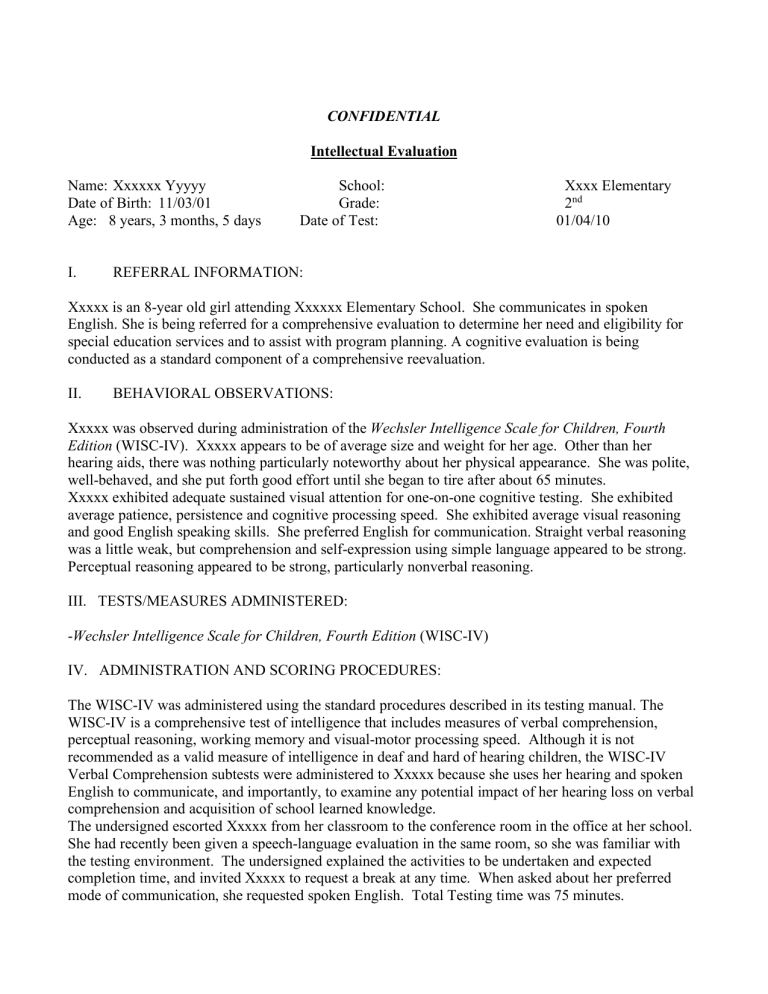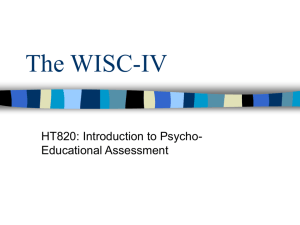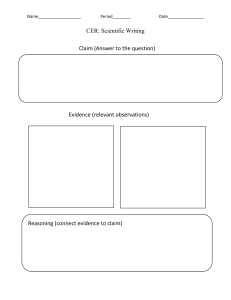
CONFIDENTIAL Intellectual Evaluation Name: Xxxxxx Yyyyy Date of Birth: 11/03/01 Age: 8 years, 3 months, 5 days I. School: Grade: Date of Test: Xxxx Elementary 2nd 01/04/10 REFERRAL INFORMATION: Xxxxx is an 8-year old girl attending Xxxxxx Elementary School. She communicates in spoken English. She is being referred for a comprehensive evaluation to determine her need and eligibility for special education services and to assist with program planning. A cognitive evaluation is being conducted as a standard component of a comprehensive reevaluation. II. BEHAVIORAL OBSERVATIONS: Xxxxx was observed during administration of the Wechsler Intelligence Scale for Children, Fourth Edition (WISC-IV). Xxxxx appears to be of average size and weight for her age. Other than her hearing aids, there was nothing particularly noteworthy about her physical appearance. She was polite, well-behaved, and she put forth good effort until she began to tire after about 65 minutes. Xxxxx exhibited adequate sustained visual attention for one-on-one cognitive testing. She exhibited average patience, persistence and cognitive processing speed. She exhibited average visual reasoning and good English speaking skills. She preferred English for communication. Straight verbal reasoning was a little weak, but comprehension and self-expression using simple language appeared to be strong. Perceptual reasoning appeared to be strong, particularly nonverbal reasoning. III. TESTS/MEASURES ADMINISTERED: -Wechsler Intelligence Scale for Children, Fourth Edition (WISC-IV) IV. ADMINISTRATION AND SCORING PROCEDURES: The WISC-IV was administered using the standard procedures described in its testing manual. The WISC-IV is a comprehensive test of intelligence that includes measures of verbal comprehension, perceptual reasoning, working memory and visual-motor processing speed. Although it is not recommended as a valid measure of intelligence in deaf and hard of hearing children, the WISC-IV Verbal Comprehension subtests were administered to Xxxxx because she uses her hearing and spoken English to communicate, and importantly, to examine any potential impact of her hearing loss on verbal comprehension and acquisition of school learned knowledge. The undersigned escorted Xxxxx from her classroom to the conference room in the office at her school. She had recently been given a speech-language evaluation in the same room, so she was familiar with the testing environment. The undersigned explained the activities to be undertaken and expected completion time, and invited Xxxxx to request a break at any time. When asked about her preferred mode of communication, she requested spoken English. Total Testing time was 75 minutes. Intellectual Evaluation Xxx 02/08/10 V. TEST RESULTS: -WISC-IV -- The Wechsler Intelligence Scale for Children, Fourth Edition, is a standard battery of tests that assesses different aspects of intellectual functioning. The WISC-IV yields four index quotients and a full-scale quotient. The indices assessed by the WISC-IV include verbal comprehension, perceptual reasoning, working memory and processing speed; considered the underlying components of intellectual functioning. The combination of the four indices is the full scale, which represents a measure of general intelligence and is derived by combining the four index scores. For the purpose of this evaluation, a near-complete WISC-IV was administered (9 of 10 subtests). The 10th subtest was omitted when it became apparent that Xxxxx’ fatigue was beginning to impact her performance. Composite scores were derived for the Verbal Comprehension, Perceptual Reasoning, and Working Memory, and a prorated Full Scale IQ was generated. All are reported below. WISC-IV: (subtest mean = 10, standard deviation = 3): Index Verbal Comprehension Vocabulary Comprehension Subtests Perceptual Reasoning Picture Concepts Matrix Reasoning Scaled score Similarities 9 13 Block Design 12 15 Working Memory Letter-Number Sequencing Digit Span 13 Processing Speed Symbol Search Coding --- Range of Performance 8 Average High Average Average 10 Average Superior Average 11 High Average Average 10 --- Average WISC-IV: (quotient mean = 100, standard deviation = 15): Index Verbal Comprehension 47th Perceptual Reasoning 84th Working Memory Scaled Score IQ – High Average Full Scale (prorated) 30 92 - 106 37 106 – 121 24 75th %ile 95% C.I. Range Performance Descriptor 99 Average 115 High Average 110 120 - 117 Average (112) 73rd 109 104 - 114 Average – High Average VI. ANALYSIS OF TEST RESULTS: -WISC-IV Results from the WISC-IV suggest above average nonverbal reasoning and problem-solving skills and average verbal comprehension and related school-learned abilities. Subtest scaled scores ranged from a low of 8 (average) on the Similarities subtest to a high of 15 (superior) on the Matrix Reasoning subtest. Intellectual Evaluation Xxx 02/08/10 The 16-point discrepancy between Xxxxx’ Perceptual Reasoning and Verbal Comprehension quotients is statistically significant (p<. 05). Xxxxx demonstrated strengths in the areas of nonverbal reasoning, expressive understanding of the rules underlying social behavior, and short term auditory working memory, and relative weaknesses in verbal reasoning and vocabulary sophistication, though both of these were about average range for her age. Xxxxx obtained a Verbal Comprehension IQ score of 99, which falls within the average range. There is a 95% chance that the range of scores from 92 to 106 includes Xxxxx’s true Verbal Comprehension IQ. Xxxxx’ subtest scores were very consistent and all were at least average, suggesting average verbal reasoning and knowledge of word meanings, and above average knowledge of the rules underlying social behavior and the ability to express that knowledge verbally. Xxxxx’s scores on the Verbal Comprehension subtests are indicative of above average verbal skills, despite her lowest WISC-IV scores being on the Similarities and Vocabulary subtests. Xxxxx obtained a Perceptual Reasoning IQ of 115, which falls within the high average range. There is a 95% chance that the range of scores from 106 to 121 includes Xxxxx’s true WISC-IV Perceptual Reasoning quotient. Xxxxx’s subtest scores were somewhat consistent, with average-range scores on the first two subtests and a superior range score on the Matrix Reasoning subtest. She demonstrated average nonverbal reasoning with internal verbal mediation, average visual-motor spatial integration skills, and superior nonverbal reasoning. Her scaled score of 12 on the Picture Concepts subtest suggests that she is learning conceptual relationships among objects, such as categories, functions of objects, and relationships among things, despite her hearing loss. In addition, her scaled score of 15 on Matrix Reasoning, suggests that nonverbal reasoning is an area of both relative and absolute strength in her cognitive profile. Visual supports are therefore recommended for her acquisition of vocabulary and verbal concepts. Her potential for learning via visual means is estimated to be above average at this time. Xxxxx obtained a Working Memory IQ of 110, which lies at the cutoff between “average” and “high average.” The chance that her true Working Memory quotient lies between 102 and 117 is 95%. This score suggests average to above average auditory memory for number strings and the ability to hold numbers in her head, manipulate them, and recall them. Xxxxx was able to recall 5 numbers forward and 4 numbers in reverse, which is average. She was able to recall the letters and numbers, separate them into number and letter groups, and put them in the correct order (up to 4), which was better than average. Xxxxx obtained a scaled score of 10 on the Coding subtest, suggesting average psychomotor processing speed and dexterity. Visual-motor coordination and speed appear to be intact. VII. SUMMARY: Xxxxx is an 8-year 3-month old second grader with a significant bilateral hearing loss for which she wears hearing aids. Her participation in and effort during the evaluation were consistent, generating valid results. Xxxxx was given a broad range of intelligence tests covering verbal and nonverbal domains. She obtained rather consistent results suggesting stronger nonverbal reasoning skills and weaker receptive language and verbal reasoning skills. Subtest scaled scores and quotients suggest at least average intelligence, with areas of relative strength and relative weakness consistent with a hearing loss that is only having a mild impact on verbal skill development, presumably due to strong residual hearing and good compensatory skills. VIII. SUGGESTIONS FOR CONSIDERATION Intellectual Evaluation Xxx 02/08/10 Xxxxx would continue to benefit from her intensive language program emphasizing integration 1. of visual supplements to promote comprehension. Please refer to the educational evaluation and speech language evaluation reports for specific recommendations in this regard. 1a. Xxxxx may require more time to process auditory information. Provide her with extra time and repetitions as needed to promote processing of information. Be careful not to caudle her too much, though. Try to focus on her “zone of proximal developent,” the space just above what she can do independently. Work on building basic vocabulary through reading and writing activities, dictionary activities, 2. crossword puzzles, etc. Make sure these activities are at her level, but as noted above, push her to work a little into her “zone of proximal development.” Xxxxx would benefit from activities to strengthen vocabulary during verbal self-expression. 3. Examples include social stories and telling/writing stories that involve using new vocabulary words.
![[Course information: prefix, number, title, credits] GENERAL EDUCATION COMPETENCY AREA:](http://s2.studylib.net/store/data/015759505_1-7b8a217fa4bf910a83e365321689e7da-300x300.png)

